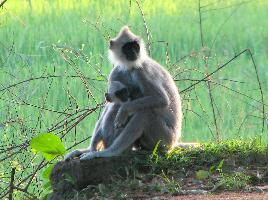
Greutăți și măsuri
| Lungime | de la 70 la 80 cm |
|---|---|
| Greutate | de la 11 la 18 kg |
| Lungimea cozii | 100 cm |
Date biologice
| Durata de viață | de la 20 la 25 ani |
|---|---|
| Durata gestației | 6 m |
| Numărul de pui | 1 - 2 |
Starea de conservare
| Amenințat |
Descrierea animalului
The Northern Plains Gray Langur (Semnopithecus entellus), also known as the Hanuman Langur, is a captivating primate that dwells predominantly in the Indian subcontinent. This species is named after Hanuman, a revered figure in Hindu mythology, highlighting its significant cultural and religious importance in the region. These langurs exhibit a fascinating blend of adaptability and social complexity, making them a subject of interest for both researchers and wildlife enthusiasts.Physically, the Northern Plains Gray Langur showcases a range of gray shades across its fur, from silvery tones to darker grays, which serves as an effective camouflage in their natural habitat. They possess a striking black face, framed by a mane of silver-gray fur, giving them a distinguished appearance. Adult males are noticeably larger than females, with both sexes featuring long, powerful tails that exceed their body length, aiding in balance and agility as they navigate through the forest canopy.
One of the most distinctive aspects of these langurs is their social structure. They live in multi-male, multi-female groups, which can range from small family units to large troops of over a hundred individuals. These groups are highly hierarchical, with a dominant male leading the troop. Social bonds within the group are maintained through a complex system of grooming, vocal communication, and cooperative caregiving, showcasing their intricate social behaviors.
The Northern Plains Gray Langur is primarily herbivorous, with a diet that includes leaves, fruit, flowers, and seeds. Their preference for leaves, which are difficult for many animals to digest due to high cellulose content, is facilitated by their specialized stomachs, allowing them to extract the necessary nutrients efficiently. This dietary adaptability enables them to thrive in a variety of habitats, from arid scrublands to lush forests.
Their habitat spans across a wide geographical area in the Indian subcontinent, including Bangladesh, Nepal, and Sri Lanka, in addition to India. They are versatile in their habitat preferences, inhabiting everything from dense forests to urban areas. In cities and towns, they are often seen in temples and other human structures, living in close proximity to humans. While this coexistence is largely peaceful, it sometimes leads to conflicts, primarily due to the langurs' tendency to raid crops and food stores.
Despite their adaptability, Northern Plains Gray Langurs face threats from habitat loss, deforestation, and hunting. They are considered sacred in many parts of their range, which offers them some protection; however, the loss of their natural habitats to agriculture and urban expansion poses significant challenges to their populations.
Conservation efforts for the Northern Plains Gray Langur include habitat preservation, legal protection, and research to better understand their ecology and behavior. As a species integral to the cultural and natural heritage of the Indian subcontinent, preserving these primates is crucial for maintaining the region's biodiversity and cultural identity.
Animale similare
Fotografii noi cu animale
Top 10 animale
- Dolphin gull (Leucophaeus scoresbii)
- Diana monkey (Cercopithecus diana)
- Moustached guenon (Cercopithecus cephus)
- Galápagos tortoise (Geochelone nigra complex)
- Japanese macaque (Macaca fuscata)
- Stone loach (Barbatula barbatula)
- Russian tortoise (Testudo horsfieldii)
- Greek tortoise (Testudo graeca)
- Common flying dragon (Draco volans)
- Vendace (Coregonus albula)


